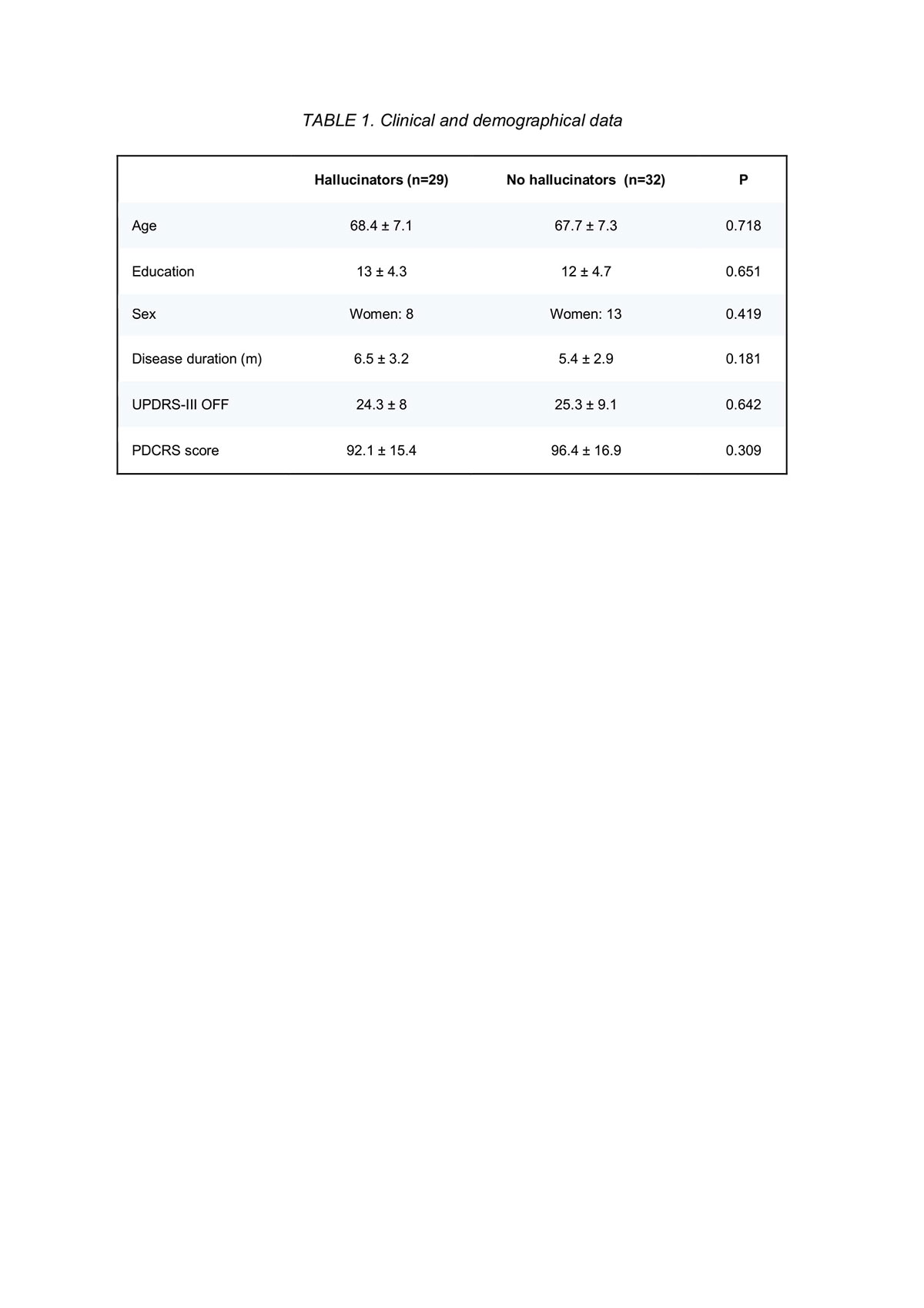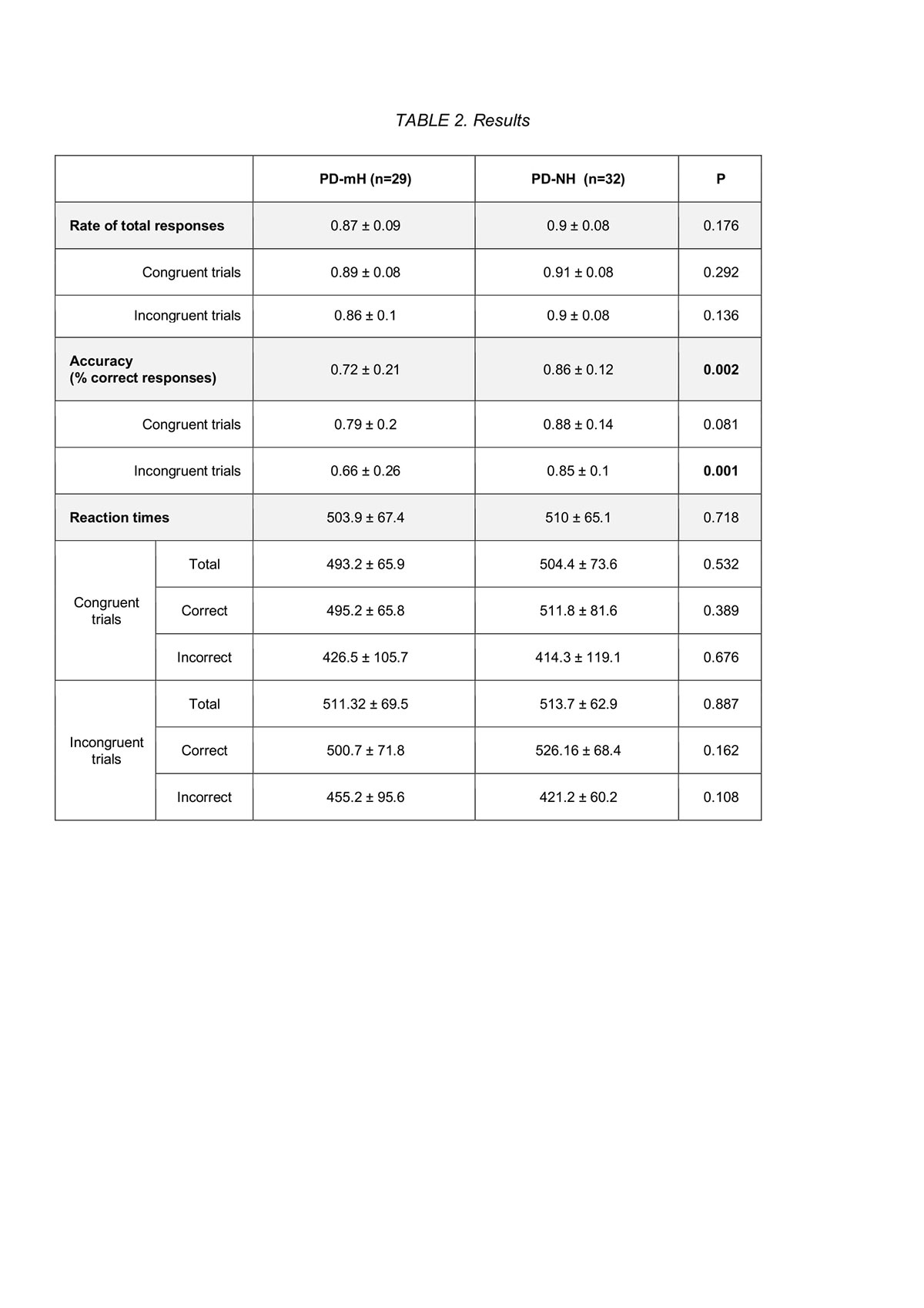Session Information
Date: Monday, September 23, 2019
Session Title: Psychiatric Manifestations
Session Time: 1:45pm-3:15pm
Location: Les Muses Terrace, Level 3
Objective: To explore attentional processing deficits in Parkinson’s disease (PD) with minor hallucinations using a selective visual attention task.
Background: Recent literature points to a similar neural basis between minor and well-structured hallucinations [1]. Increasing clinical and neuroimaging data support a participation of attentional processes in the pathophysiology of well-structured hallucinations [2]. Determining their involvement on minor hallucinations would help to understand the relationship between different stages of psychosis in PD.
Method: Sixty-one patients with early-to-moderate PD (n=29 with minor hallucinations, PD-mH; n=32 without hallucinations, PD-NH), perfectly matched for confounding factors, were included in the analysis. A modified version of the Ericksen flanker test was used to explore attentional processes. Both accuracy and reaction times were recorded. Each participant completed 1000 trials. A 19-channel EEG was performed during the task administration. Significance was set at p<0.05.
Results: The PD-mH group had significant lower accuracy compared to non-hallucinators (p=0.001), especially in incongruent trials (p=0.003). Although no statistically significant, longer reaction times in incorrect responses were found in this group, suggesting that this finding cannot be entirely explained by poor inhibition control. In ERP recordings, we found that patients with minor hallucinations showed lower mean amplitudes in P200 at midline frontal electrode (Fz), and in P300 at midline parietal electrode (Pz) during incorrect incongruent trials.
Conclusion: Our results reveal that patients with PD and minor hallucinations show impairments in attention-modulated higher-order perceptual processing, and reduced ability to control attentional focus, in line with previous descriptions in patients with well-structured hallucinations. These findings further support the presence of common neural changes along the clinical spectrum of psychosis in PD.
References: [1] Bejr-Kasem H, Pagonabarraga J, Martínez-Horta S, Sampedro F, et al. Disruption of the default mode network and its intrinsic functional connectivity underlies minor hallucinations in Parkinson’s disease. Mov Disord. 2019 Jan;34(1):78-86. [2] Hall JM, O’Callaghan C, Shine JM, Muller AJ, et al. Dysfunction in attentional processing in patients with Parkinson’s disease and visual hallucinations. J Neural Transm. DOI 10.1007/s00702-016-1528-3.
To cite this abstract in AMA style:
H. Bejr-Kasem, J. Pagonabarraga, S. Martínez-Horta, F. Ruiz-Martínez, F. Bernasconi, F. Sampedro, J. Marín-Lahoz, A. Horta-Barba, I. Aracil-Bolaños, B. Pascual-Sedano, O. Blanke, J. Kulisevsky. The role of dysfunctional attentional processing in isolated minor hallucinations in Parkinson’s disease [abstract]. Mov Disord. 2019; 34 (suppl 2). https://www.mdsabstracts.org/abstract/the-role-of-dysfunctional-attentional-processing-in-isolated-minor-hallucinations-in-parkinsons-disease/. Accessed April 26, 2025.« Back to 2019 International Congress
MDS Abstracts - https://www.mdsabstracts.org/abstract/the-role-of-dysfunctional-attentional-processing-in-isolated-minor-hallucinations-in-parkinsons-disease/


